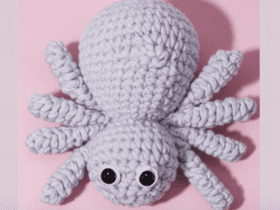Table of Contents
Create Elegant a stunning pink flamingo amigurumi with this detailed pattern guide. This elegant lady flamingo combines classic amigurumi techniques with unique shaping methods to create a graceful bird with character and charm. Perfect for intermediate crocheters, this step-by-step tutorial will help you craft a beautiful handmade flamingo that’s sure to become a treasured piece in any collection.
Introduction to Flamingo Amigurumi Crochet
Amigurumi—the Japanese art of crocheting small stuffed toys—takes an elegant turn with this lady flamingo design. Flamingos are known for their distinctive pink coloration, long graceful necks, and slender legs—all features that make them uniquely challenging and rewarding to recreate in crochet form. This pattern guides you through creating a flamingo with proper proportions and stability, using wire reinforcement for the neck and legs to achieve the bird’s characteristic pose.
Essential Materials for Your Amigurumi Flamingo
Before Elegant beginning your flamingo project, gather these materials:
- Medium weight yarn in:
- Pink (for the body and head)
- White (for head details)
- Gray (for head details)
- Black (for beak)
- Fluffy or textured pink yarn (for a feathery body texture)
- Crochet hook appropriate for your yarn (typically 3.0-3.5mm)
- Polyester fiberfill stuffing
- Armature wire for neck and legs support
- Wire cutters
- Yarn needle
- Scissors
- Stitch markers
- Safety eyes (optional, can be embroidered instead)
Understanding Elegant Terminology
Familiarize yourself with these standard abbreviations used throughout the pattern:
- sc – Single crochet: The fundamental stitch for amigurumi
- DC – Double crochet: Creates height and is used for decorative elements
- HDC – Half double crochet: A medium-height stitch
- sl-st – Slip stitch: Used to join rounds or move position without adding height
- loop – Lifting loop at the end of a row
- ch – Chain: Creates a series of linked stitches
- inc – Increase: Creating two stitches in one stitch
- dec – Decrease: Combining two stitches into one
- Magic ring: A technique to start crocheting in the round with no hole in the center
Creating the Flamingo’s Head and Beak
The flamingo’s distinctive head shape begins with the characteristic curved beak. Using black yarn:
- Create a magic ring and work 6 single crochets into the ring
- Work (2 single crochets, increase) twice (8 stitches)
- Work 8 single crochets
- Work (3 single crochets, increase) twice (10 stitches)
- Work 10 single crochets
- Work 8 single crochets, chain 1, turn
- Work 8 single crochets, chain 1, turn
- Work 1 single crochet, decrease, 2 single crochets, decrease, 1 single crochet (6 stitches), chain 1, turn
- Work 1 single crochet, 2 decreases, 1 single crochet (4 stitches), chain 1, turn
- Work around the entire piece: 4 single crochets along the back edge, 3 single crochets along the side, 2 single crochets along the front, 3 single crochets along the other side (12 stitches total)
- Work (5 single crochets, increase) twice (14 stitches)
Begin transitioning to the head: 12. Change to gray yarn: Work (6 single crochets, increase) twice (16 stitches) 13. Change to white yarn: Work (7 single crochets, increase) twice (18 stitches) 14. Work 18 single crochets 15. Work (8 single crochets, increase) twice (20 stitches) 16. Work (4 single crochets, increase) 4 times (24 stitches)
Continue with the main head: 17. Change to pink yarn: Work (5 single crochets, increase) 4 times (28 stitches) 18. Work (6 single crochets, increase) 4 times (32 stitches) 19. Work (7 single crochets, increase) 4 times (36 stitches) 20. Work (5 single crochets, increase) 6 times (42 stitches) 21-22. Work 2 rounds of 42 single crochets 23. Work (6 single crochets, increase) 6 times (48 stitches) 24-29. Work 6 rounds of 48 single crochets
Begin decreasing to shape the neck: 30. Work (6 single crochets, decrease) 6 times (42 stitches) 31. Work 42 single crochets
Important: At this point, insert wire into the head for neck support. Ensure the wire extends long enough to run through the entire neck.
- Work (5 single crochets, decrease) 6 times (36 stitches)
- Work (4 single crochets, decrease) 6 times (30 stitches)
- Work (3 single crochets, decrease) 6 times (24 stitches)
- Work (2 single crochets, decrease) 6 times (18 stitches) 36-78. Work 43 rounds of 18 single crochets to create the long neck
Ensure the wire is centered in the neck as you stuff and continue crocheting.
Elegant Forming the Flamingo Body
The body attaches to the base of the neck and creates the round, feathered torso of your flamingo:
- Work (8 single crochets, increase) twice (20 stitches)
- Work (9 single crochets, increase) twice (22 stitches)
- Work (10 single crochets, increase) twice (24 stitches)
Note: At this point, switch to fluffy or textured pink yarn to create a feathery effect.
- Work (3 single crochets, increase) 6 times (30 stitches)
- Work (4 single crochets, increase) 6 times (36 stitches)
- Work (5 single crochets, increase) 6 times (42 stitches)
- Work (6 single crochets, increase) 6 times (48 stitches)
- Work (7 single crochets, increase) 6 times (54 stitches)
- Work (8 single crochets, increase) 6 times (60 stitches)
- Work (9 single crochets, increase) 6 times (66 stitches)
- Work (10 single crochets, increase) 6 times (72 stitches)
- Work (11 single crochets, increase) 6 times (78 stitches) 13-23. Work 11 rounds of 78 single crochets
Begin decreasing to shape the lower body: 24. Work (11 single crochets, decrease) 6 times (72 stitches) 25-26. Work 2 rounds of 72 single crochets 27. Work (10 single crochets, decrease) 6 times (66 stitches) 28-29. Work 2 rounds of 66 single crochets 30. Work (9 single crochets, decrease) 6 times (60 stitches) 31. Work 60 single crochets 32. Work (8 single crochets, decrease) 6 times (54 stitches) 33. Work 54 single crochets 34. Work (7 single crochets, decrease) 6 times (48 stitches) 35. Work 48 single crochets 36. Work (6 single crochets, decrease) 6 times (42 stitches) 37. Work 42 single crochets 38. Work (5 single crochets, decrease) 6 times (36 stitches) 39. Work 36 single crochets 40. Work (4 single crochets, decrease) 6 times (30 stitches) 41. Work 30 single crochets 42. Work (3 single crochets, decrease) 6 times (24 stitches) 43. Work 24 single crochets 44. Work (2 single crochets, decrease) 6 times (18 stitches) 45. Work 17 single crochets 46. Work (1 single crochet, decrease) until 12 stitches remain 47. Work 6 decreases to close the opening (6 stitches)
Fasten off, leaving a long tail. Pull tight to close the opening and weave in the end.
Elegant Creating the Flamingo Legs
The characteristic long, thin legs are a distinctive feature of flamingos. Make two identical legs:
Starting with the toes (make two toes for each foot):
- Create a magic ring and work 6 single crochets into the ring
- Increase in each stitch (12 stitches)
- Work (3 single crochets, increase) 3 times (15 stitches) 4-7. Work 4 rounds of 15 single crochets
Join the two toes together by working across both pieces: 8. Work across both toes to create one piece (30 stitches total) 9-10. Work 2 rounds of 30 single crochets 11. Work (3 single crochets, decrease) 6 times (24 stitches) 12-13. Work 2 rounds of 24 single crochets 14. Work (2 single crochets, decrease) 6 times (18 stitches) 15-16. Work 2 rounds of 18 single crochets
Create the opening for the leg: 17. Work 7 single crochets, chain 6, skip 7 single crochets, work 6 single crochets into chain 18-19. Work 2 rounds of 18 single crochets 20. Work (1 single crochet, decrease) 6 times (12 stitches) 21. Work 12 single crochets 22. Work 6 decreases to close the foot (6 stitches)
For the leg portion: Thread wire through the opening you created in row 17 and work 30 rows of straight single crochet around the wire to create the long, slender leg. Ensure the wire is positioned securely and centered as you work.
Crafting the Flamingo Wings
The wings add dimension and character to your flamingo:
- Create a magic ring and work 6 single crochets into the ring
- Increase in each stitch (12 stitches)
- Work (1 single crochet, increase) 6 times (18 stitches)
- Work (2 single crochets, increase) 6 times (24 stitches)
- Work (3 single crochets, increase) 6 times (30 stitches)
- Work (4 single crochets, increase) 6 times (36 stitches)
- Work (5 single crochets, increase) 6 times (42 stitches)
- Work (6 single crochets, increase) 6 times (48 stitches)
- Work (7 single crochets, increase) 6 times (54 stitches)
- Work (8 single crochets, increase) 6 times (60 stitches)
Fasten off leaving a long tail. Fold the wing in half and sew the edges together. Attach the wing to the body.
Elegant Assembly Instructions
Now that you’ve created all components, it’s time to assemble your flamingo:
- Head and Neck:
- Ensure the wire runs securely through the neck
- Add stuffing around the wire, keeping it centered
- Shape the neck into the characteristic flamingo curve
- Body:
- Stuff the body firmly, especially at the base where it will support the flamingo’s weight
- Attach the neck to the body, ensuring the wire extends into the body for stability
- Shape the body into a rounded form
- Legs:
- Insert wire through each leg for support
- Attach the legs to the bottom of the body
- Position them to create a stable base with one leg slightly forward for a natural pose
- Wings:
- Fold each wing in half
- Sew the wings to the sides of the body
- Position them so they lie flat against the body or in a slightly raised position
- Final Details:
- Add safety eyes or embroider eyes onto the head
- Ensure all parts are securely attached
- Shape the flamingo into the desired pose, using the wire to adjust the neck and legs
Elegant Understanding Wire Reinforcement Techniques
This flamingo pattern requires wire reinforcement for stability and proper posing. Here’s how to work with the wire effectively:
Elegant Preparing the Wire
- Measuring: Cut wire pieces that are at least 20% longer than the finished parts they’ll support
- Safety First: Fold both ends of each wire piece back on itself to create small loops that prevent sharp ends from poking through
- Positioning: For the neck, insert wire after completing row 31 of the head
- Securing: Keep the wire centered as you continue crocheting and stuffing
Elegant Working Around Wire
- Centering: As you stuff around the wire, distribute fiberfill evenly to keep the wire centered
- Tension: Crochet with consistent tension around the wire to avoid visible gaps
- Adjustments: If the wire shifts, use a crochet hook or blunt needle to reposition it before continuing
- Testing: Periodically check that the wire allows the desired flexibility and support
Elegant Creating Stable Legs
- Two-Wire System: For extra stability, consider using two thinner wires twisted together for each leg
- Base Support: Have the leg wires extend at least 1-2 inches into the body for secure anchoring
- Balance: Position the legs slightly apart at the base to create a stable tripod effect with the body
- Poseable Toes: For added realism, extend small wire pieces into each toe
Elegant Mastering Color Transitions
This flamingo uses several color changes to create the distinctive head markings. Here’s how to handle them smoothly:
- Complete Last Stitch: When changing colors, work the last stitch of the current color until two loops remain on your hook
- Yarn Over with New Color: Complete the stitch using the new color yarn
- Carry or Cut: For closely spaced color changes (like the head), carry the unused yarn inside your work
- Weave Ends: Secure color change points by weaving in ends as you stuff
Elegant Customization Ideas
Make your flamingo uniquely yours with these creative variations:
- Embellishments: Add a small crown or flower to create a fancy lady flamingo
- Size Adjustments: Scale the pattern up or down by changing yarn weight and hook size
- Color Variations: Create a white flamingo or use a gradient of pink shades for the body
- Textural Elements: Add feather-like details using surface crochet or yarn brushing techniques
- Posture Options: Adjust the wire to create different poses—standing tall, neck curved, or even sleeping
Troubleshooting Common Issues
If you encounter problems during your project:
- Wobbly Structure: Reinforce wire connections and ensure they extend far enough into connecting parts
- Uneven Neck: Check that stitches around the wire maintain consistent tension
- Balance Problems: Adjust leg positions or add weight to the feet for better stability
- Gaps in Stitches: Tighten tension or decrease hook size for more compact stitches
- Difficulty with Toe Join: Use stitch markers to ensure even stitch counts when joining toes
Understanding the Special Shaping Techniques
Beak Shaping Method
The flamingo’s distinctive curved beak is created using partial rows and working in the round:
- Flat Section (rows 6-9): Creates the curve by working back and forth in rows
- Joining (row 10): Works around the entire piece to create a three-dimensional form
- Expansion (rows 11-16): Increases systematically to create the transition from beak to head
This technique creates the characteristic downward curve of the flamingo’s beak without complex shaping or separate pieces.
Neck Length Management
Creating the long, thin neck requires patience and attention to tension:
- Consistent Stitch Count: Maintaining 18 stitches for 43 rounds creates the slender, uniform neck
- Wire Support: The internal wire prevents the neck from collapsing or bending unintentionally
- Gradual Stuffing: Add small amounts of stuffing as you go to maintain even thickness

Check this out :Crochet an Adorable Bull and Cow Couple Amigurumi Pattern
Conclusion
Creating this amigurumi flamingo combines several advanced crochet techniques into one elegant project. The pattern introduces wire reinforcement, strategic color changes, and specialized shaping methods that elevate your amigurumi skills to new levels.
Your finished flamingo, with its graceful neck, delicate legs, and feminine charm, makes a striking display piece and a wonderful gift for bird lovers. The techniques learned in this project—including wire reinforcement, creating stable but slender structures, and achieving proper balance—build valuable skills that transfer to many other advanced amigurumi designs.
Remember that amigurumi is both a craft and an art form—feel free to experiment with poses, colors, and embellishments to make your flamingo uniquely yours. Your handcrafted flamingo represents not just a toy but a sculptural piece that showcases your developing mastery of the amigurumi craft.
If you share photos of your finished flamingo on social media, consider tagging the original pattern creator to show appreciation for their design. Happy crocheting!












Leave a Reply